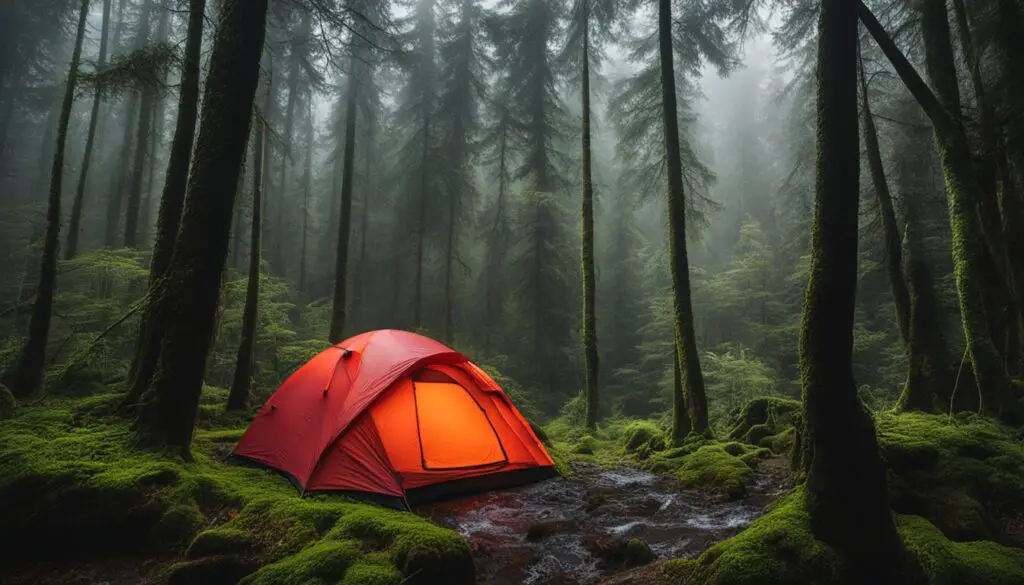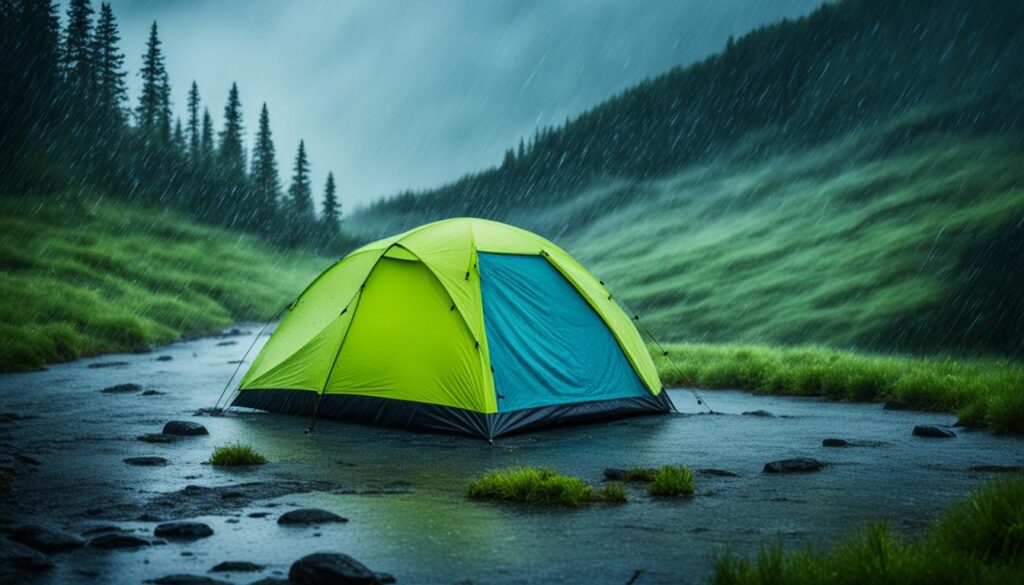Are Camping Tents Waterproof
I love camping and often wonder if my tents are really waterproof. It’s awful to wake up with a wet sleeping bag. So, let’s dive into tent waterproofing. We’ll look at different coatings, how setting up correctly matters, and things that influence waterproofing.
Knowing how waterproof my camping gear is vital for a good trip. This article will help me understand if my tents can keep dry. I’ll also learn how to keep their waterproofing working well. Let’s find out how to stay dry while enjoying the outdoors.
Understanding Tent Waterproofing
It’s key to make sure a camping tent keeps you dry. Knowing the different waterproof coatings for tent fabrics is important. Also, setting up the tent correctly helps make it more water-resistant.
Types of Waterproof Coatings
There are many ways to make a tent waterproof. We use coatings like polyurethane (PU), silicone, and fluoropolymer. These make a barrier that stops water from getting inside.
Polyurethane (PU) coatings are priced well and work fine. Silicone coatings breathe better and last longer. Fluoropolymer-based finishes, like in Gore-Tex, are great at keeping water out and holding up over time.
Importance of Proper Tent Setup
Setting up the tent right is very important. It keeps the waterproof coatings working well. Making sure the tent is tight and the stakes are in correctly helps a lot.
It’s also smart to put the tent on a flat, dry spot. Stay away from places that collect water. And, check the tent regularly for any tears or damage. Fixing these keeps the tent waterproof for a long time.
When you know about waterproof coatings and set up your tent right, you stay dry. This makes camping a fun and comfortable adventure.
Factors Affecting Tent Waterproofness
Tent waterproofness depends on various main factors. These include the tent’s age, wear, and the weather and terrain it faces. Knowing these elements helps have a dry and comfy camp.
Age and Wear of the Tent
A tent’s waterproof level changes with age and condition. The waterproof parts can weaken over time. This happens faster if the tent’s often used, left in the sun, or stored poorly. Such conditions may lessen the tent’s ability to keep water out.
Weather Conditions and Terrain
Weather and the ground’s roughness hugely affect how dry your tent stays. Rain, wind, snow, and even sharp rocks can make a tent leak. The ground’s harshness can also damage the tent, reducing its waterproofness.
| Factor | Impact on Tent Waterproofness |
|---|---|
| Tent Age and Wear | Degradation of waterproof coatings and fabrics, leading to decreased water resistance |
| Weather Conditions | Heavy rainfall, strong winds, and exposure to snow or ice can challenge a tent’s water-resistant capabilities |
| Terrain | Rough terrain with sharp rocks or uneven ground can cause abrasion and damage to the tent fabric, reducing waterproofness |
Before picking a tent, it’s good to know what makes it keep water out. And, how to take care of it for a dry camping trip. This way, you can be ready for any weather or ground.
Are Camping Tents Waterproof?
Waterproofing your camping tent is key to a great trip. A tent that leaks can ruin your fun. Luckily, most tents today keep water out well, making your stay dry and cozy.
The fabric and design of a tent decide how well it keeps you dry. Good tents have special coatings that stop water. They’re rated by how much water pressure they can handle before leaking. The higher this number, the more waterproof the tent is.
| Waterproof Rating (mm) | Waterproofness |
|---|---|
| 1,000-3,000 | Light/Moderate Rain |
| 3,000-5,000 | Heavy Rain |
| 5,000-10,000 | Extreme Weather |
Even the best waterproof tents can sometimes let water in during heavy rain. A tent’s age, how it’s set up, and if it’s worn out affect how well it keeps dry. Taking good care of your tent can make it last longer and work better against water.
Pick your tent based on its waterproof rating. This number shows how well it can handle different weather. Choosing the right waterproof level keeps you dry during every adventure, even when it rains.

Maintaining Tent Waterproofing
Keeping your tent dry is key for comfy outdoor times. If you clean and reproof it often, your tent will last longer.
Cleaning and Reproofing Techniques
Here are some steps to keep your tent waterproof:
- Clean the Tent Fabric: Use a mild soap and water to wash gently. Don’t use harsh cleaners or scrub hard; it might ruin the waterproof layer.
- Dry the Tent Thoroughly: The tent must be completely dry before reproofing. Dry it outside in the wind, or use a fan to quicken the process.
- Apply Tent Reproofing: After cleaning and drying, use a special waterproofing treatment. It makes the fabric water-resistant again, keeping your tent dry.
- Follow the Manufacturer’s Instructions: Be sure to read and do as the reproofing product’s instructions say. This makes sure you do everything right, for the best outcome.
Keep your camping tent clean and reproofed often. This will keep it waterproof and last you through many more fun outdoor trips.
Choosing the Right Waterproof Tent
Choosing a good waterproof tent is important for your trips. A good tent keeps you dry and comfy during outdoor fun. Let’s look at the must-have features in a waterproof camping tent.
First, check the waterproof rating. It shows how much water pressure the fabric can resist. A 1,500mm rating makes a tent waterproof. But, for top protection in heavy rain, pick a tent with 3,000mm or more. Tent floors need an even higher rating to be durable.
Next, the waterproof coating on the fabric is key. Silnylon is more durable than polyurethane-coated polyester. Also, make sure the seams are sealed to stop water seepage.
- Look for tents with a minimum waterproof rating of 1,500mm for the fly and 3,000mm for the floor.
- Prioritize tents with silicone-coated nylon (silnylon) fabric for superior waterproofing.
- Ensure the tent has taped or welded seams to prevent water from seeping through.
- Consider the type of tent (hiking, family, etc.) and choose one suitable for your specific camping needs and expected weather conditions.
| Tent Type | Minimum Waterproof Rating | Recommended Waterproof Rating |
|---|---|---|
| Hiking/Backpacking Tent | 1,500mm fly, 3,000mm floor | 3,000mm fly, 5,000-10,000mm floor |
| Family/Car Camping Tent | 1,500mm fly, 3,000mm floor | 3,000mm fly, 5,000-10,000mm floor |
| 4-Season Tent | 3,000mm fly, 5,000mm floor | 5,000-10,000mm fly, 5,000-10,000mm floor |
Thinking about these important things make finding the right tent easier. It ensures you stay dry and cozy, no matter the weather. Also, look into other waterproofing steps to make your camping better.
Supplementary Waterproofing Measures
While tents offer a dry space, they may need extra help in wet spots. Regions like Hawaii or the Carolinas often face heavy rain. To boost your tent’s waterproofing, consider tent footprints and tarps. These gear pieces add a protective layer. They stop leaks and block water from the ground.
Using Tent Footprints and Tarps
Tent footprints are ground covers smaller than your tent. They shield from wet or bumpy ground below. Common materials for footprints include polyethylene or tarpaulin. By using one, you avoid water damage inside your tent. It’s a smart move for a drier camp.
Adding a tarp or groundsheet boosts protection further. A tarp above or under your tent serves as a rain blocker. It’s key in rainy places, keeping you dry. So, don’t forget to pack one for your adventure.
FAQ
What are the different types of waterproof coatings used on camping tents?
Most camping tents use waterproof coatings like polyurethane (PU), silicone, and fluoropolymer. These coatings make a water-repelling barrier. It stops water from getting inside.
Why is proper tent setup important for maintaining waterproofness?
Setting up your tent right is very important. You need to tighten the guy lines, stake the corners, and check the rain fly. A proper setup keeps your tent from leaking.
How does the age and wear of a tent affect its waterproofness?
As tents get older, their waterproof coatings may wear off. This happens from the sun, rubbing, and the elements. Without a good coating, your tent won’t keep the water out as well.
How do weather conditions and terrain impact a tent’s waterproofness?
Heavy rain, strong winds, and rough ground test a tent’s ability to keep you dry. The tent’s design and the quality of its waterproofing matter. Some tents handle bad weather better than others.
What steps can be taken to maintain a tent’s waterproofing?
Clean your tent regularly and check it for damage. Use special cleaners and reproofing treatments. This helps the coating stay water-repellent.
What features should I look for when choosing a waterproof camping tent?
Look for tents with high hydrostatic heads, taped seams, and strong rain flies. Compare the waterproof ratings and construction. This ensures your tent keeps you dry during camping.
How can I use tent footprints and tarps to supplement a tent’s waterproofness?
Put a footprint or groundsheet under your tent to block moisture. It stops water from the ground. A tarp above your tent keeps rain off. This adds extra protection from bad weather.
